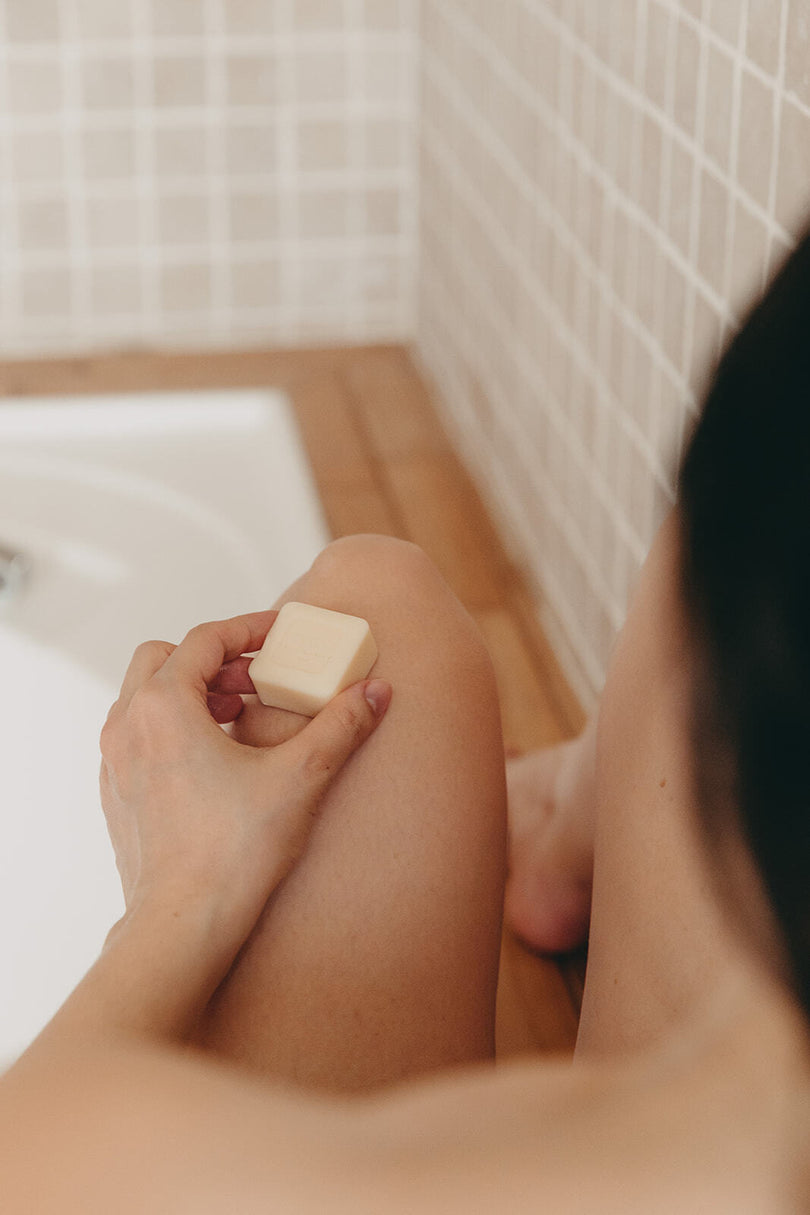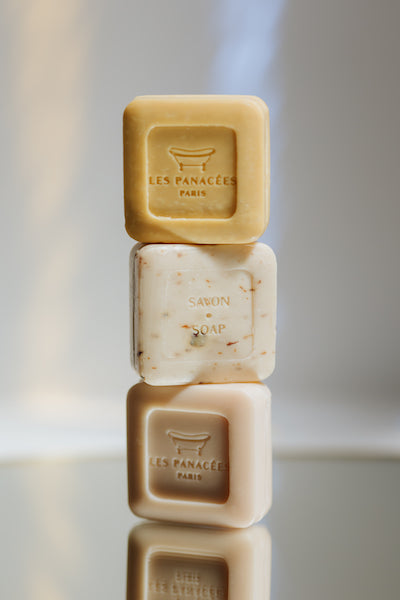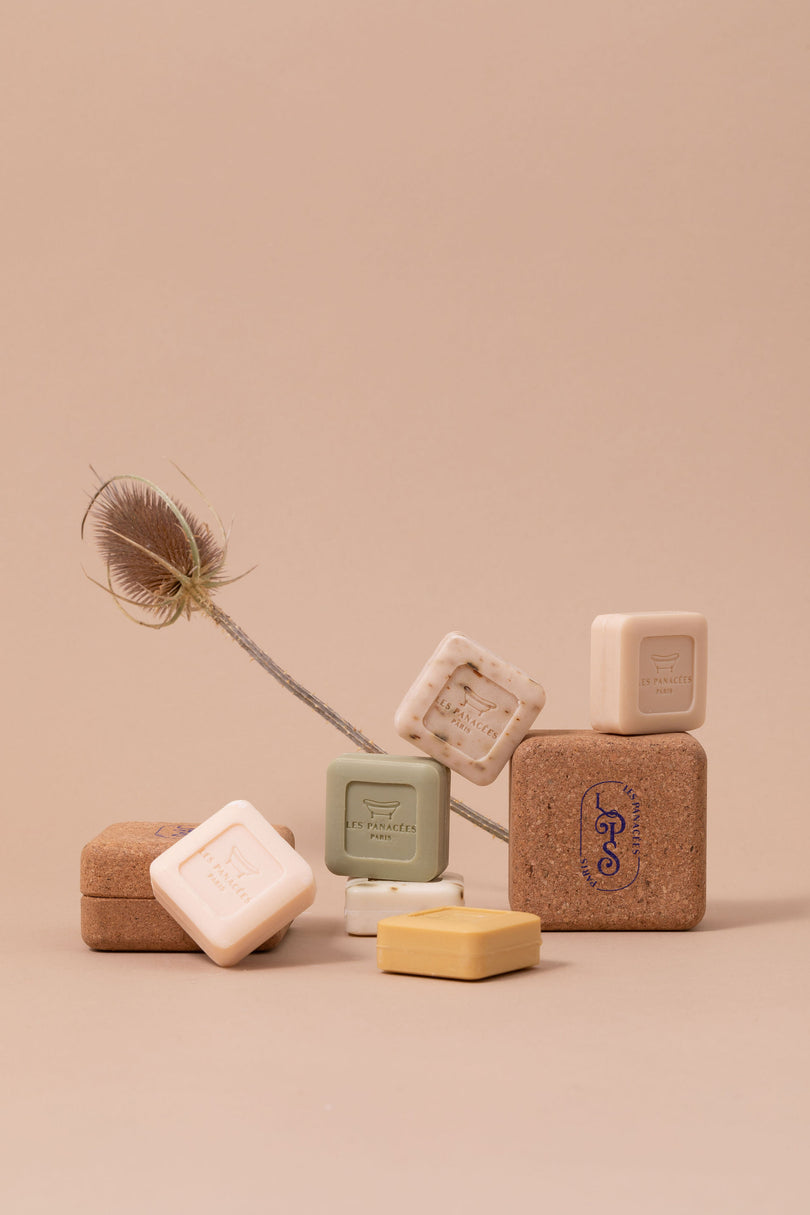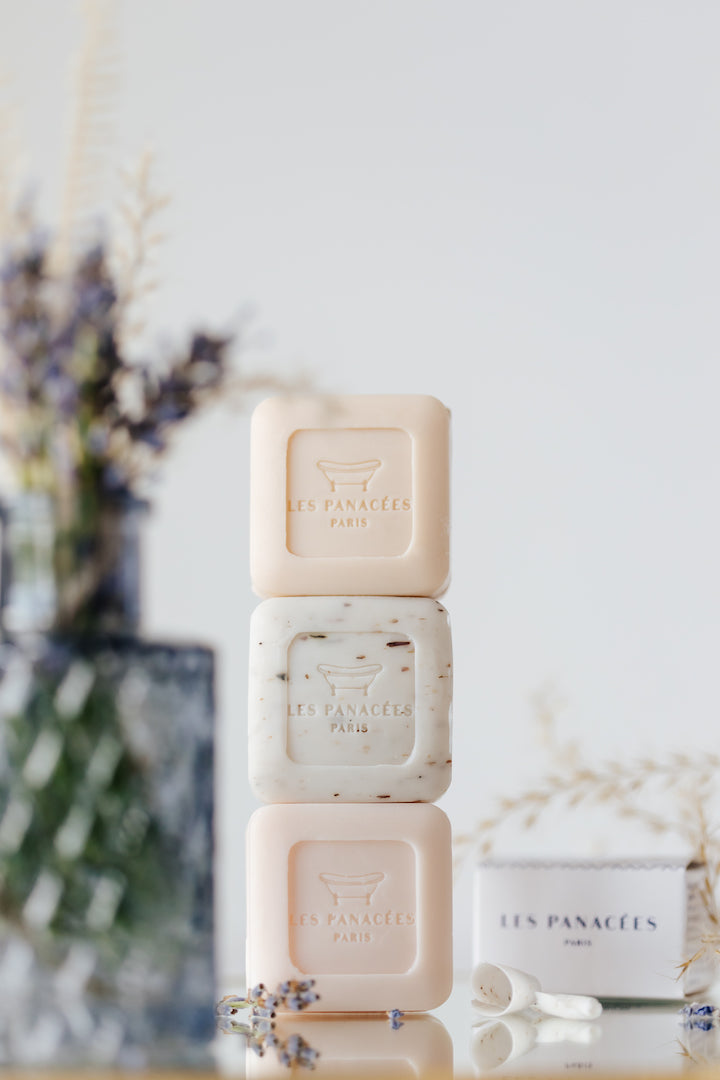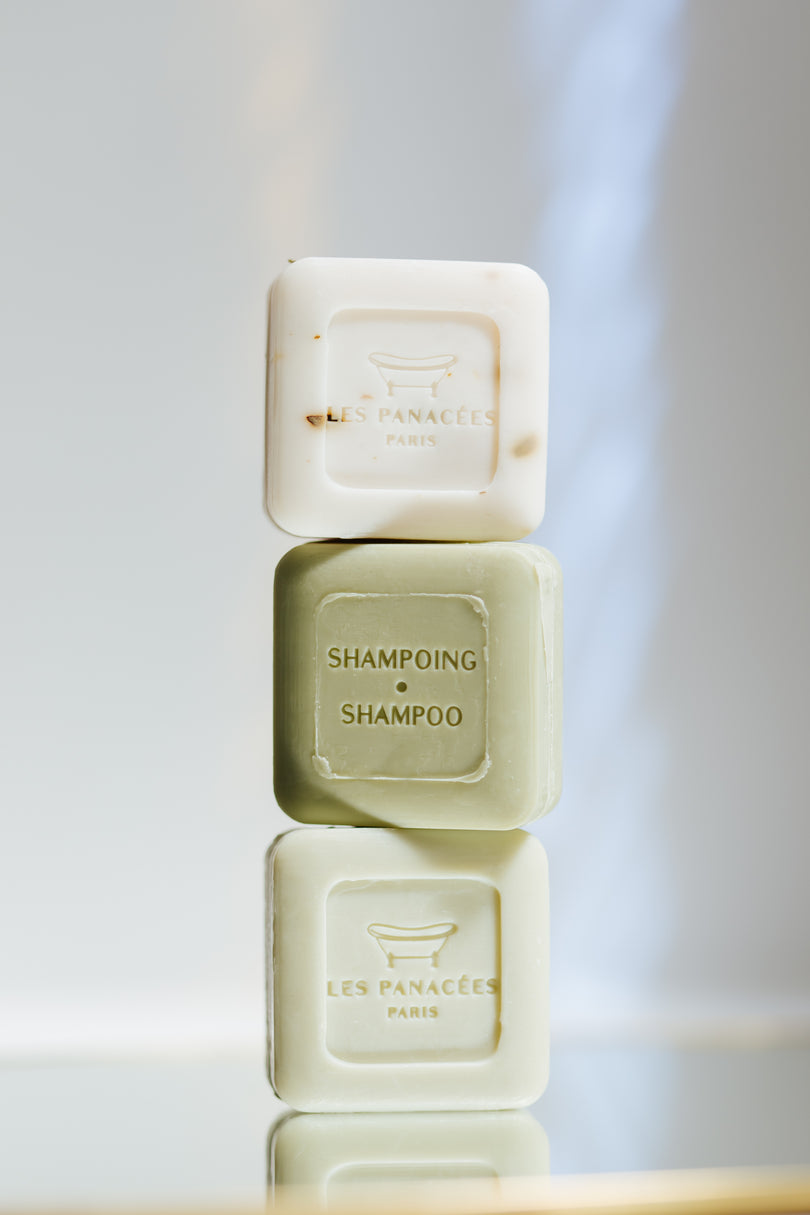Alpha-Isomethyl Ionone
INCI ingredient: satisfactory
Origin: synthetic
Classification: Allergen, Regulated
Alpha-isomethyl Ionone is colorless and is widely used in perfumery for its floral notes reminiscent of violet or iris. This substance is present in our Bouquet de Nature fragrance. You will therefore find it in the INCI lists of our shampoos, conditioners, soaps and other products in the range. NATURE BOUQUET.
It is one of 26 allergens of natural or synthetic origin regulated by Europe.
Natural or synthetic molecules capable of causing an allergic reaction are extremely numerous, but these 26 substances, of which alpha-isomethyl Ionone is one, are obligatorily labeled when they are present at more than 0.001% in the leave-in products and 0.01% in those which are rinsed. Allergens are indicated at the end of the list of ingredients, they are very common in all types of products. Note, however, that the words "tested under dermatological control", "hypoallergenic" or "sensitive skin" in no way guarantee the absence of these allergens.
Alpha-isomethyl ionone is also found in liquid cosmetics as a skin care agent because it keeps the skin in good condition.
Anise alcohol
INCI ingredient: satisfactory
Origin: synthetic
Classification: Allergen, Regulated
This odorous molecule is one of the 26 allergens regulated by Europe (cf: alpha-isomethyl Ionone). It is found in its natural state in anise, cumin, tomato or even honey. In fact, it is for its aromatic notes of honey that we have chosen it to make the Summer Tourbillon fragrance.
This substance is present in our perfume SUMMER TOURBILLON. However, you will only find it in the INCI list of our mild soap and moisturizing body balm in the range because the concentration of this molecule is less than 0.01% in our shampoos and conditioners.
Brassicyl Valinate Esylate (and) Brassica Alcohol
INCI ingredient: Well-compatible BIO
Origin: derived from plants
Origin: USA
Natural and biodegradable, brassicyl Valinate Esylate et brassica alcohol or also called AminoSencyl HC, is an ingredient 100% of natural origin, quat-free (that is to say without pesticides) and derived from the amino acid of valine and rapa brassica seed oil.
The amino acid of valine is biosynthesized in plants. Its name comes from valerian. As for brassica rapa oil, it is a plant that we call field shuttle which is from the Brassicaceae family (like cabbages or turnips for example).
We add this ingredient in our conditioners to provide a hair conditioning effect without weighing down the hair. It leaves hair manageable, soft, supple and shiny. It also brings volume, lightness and hydration to the fiber. Unlike conventional conditioners or masks containing a lot of silicones, our conditioners do not fill in the scales of the hair fiber and therefore do not give the false sensation of having repaired the lengths of the hair. On the contrary, AminoSencyl will sheath and bring a supple and light touch to the hair without weighing it down. It will also redefine the true nature of the hair and strengthen it.
This ingredient is also an emollient, it will soften and soften the skin.
Finally, you will see that our conditioners foam slightly. The reason is simple: we add ICS (cf: SCI) in our conditioners for the reasons listed below and AminoSencyl is an emulsion stabilizer and will aid the emulsification process.
Benzyl alcohol
INCI ingredient: satisfactory
Origin: synthetic
Classification: Allergen, Regulated
This odorous molecule is one of the 26 allergens regulated by Europe (cf: alpha-isomethyl Ionone). It is found naturally in jasmine, garlic, ylang ylang, apricot, almond or blackcurrant.
Benzyl salicylate
INCI ingredient: satisfactory
Origin: synthetic
Classification: Allergen, Regulated
This odorous molecule is one of the 26 allergens regulated by Europe (cf: alpha-isomethyl Ionone). It is produced naturally by many plants and is used as a scent molecule in perfumed products: it is known for its light and balsamic, even musky scents.
Butyrospermum parkii butter organic *
INCI ingredient: Well-compatible BIO
Origin: vegetable
Origin: Burkina
Vegetable shea butter is present in our conditioners and balms moisturizers for the body. For the hair, it will nourish and strengthen the hair fiber and make the hair flexible and easy to comb, particularly for curly, frizzy or frizzy hair.
For the skin, our balm will protect, soften and soften the epidermis, thanks in particular to shea butter. Finally, its thick texture allows our solid balm to be molded and gives it more hold.
Its properties are explained by its content of triglycerides, fatty acids, wax esters and active ingredients such as vitamins (A, D, E), resinous esters, phytosterols, and latex.
Organic Candelilla cera *
INCI ingredient: Well-compatible BIO
Origin: vegetable
Origin: Mexico
This ingredient is presentnt in our moisturizing solid balm for the body. Candelilla wax helps to solidify the balm but also to soften and soften the skin. When you use our balm, you will see that it will create a continuous film on the skin and will help retain moisture in the shea butter and coconut oil present in the balm for at least 12 hours. Using this wax rather than beeswax allows us to say that our products are vegan.
This wax is obtained from euphorbia cerifera, a shrub that grows mostly in Mexico.
CI 11680
INCI ingredient: satisfactory
Origin: synthetic
Origin: France
This ingredient is a so-called azo dye used for its yellow color that is found in our solid shampoo SUMMER TOURBILLON.
Azo dyes are used in cosmetics, pharmaceuticals, inks, paints, synthetic and natural textile fibers, hair dyes, waxes, etc. These dyes are therefore everywhere in our daily life. But are these dyes used in cosmetics dangerous? Some of these dyes can release amines classified as carcinogens but these are not used in cosmetics and, moreover, often banned in Europe.
CI 77007
INCI ingredient: satisfactory-compatible BIO
Origin: mineral
CI 77007 is a blue colorant found in our mild soap BOUQUET OF NATURE. This dye is one of the blue constituents of Lapis-Lazuli, a metamorphic rock, containing silicates of the feldspathoid group.
CI 77288
INCI ingredient: satisfactory-compatible BIO
Origin: mineral
This ingredient is a green colorant found in our shampoo, conditioner and mild soap of the range IN THE SHADOW OF THE CYPRESSES.
CI 77491
INCI ingredient: satisfactory-compatible BIO
Origin: mineral
This ingredient is a red colorant also referred to as Iron trioxide. We mixed it with other iron oxides like CI 77492 (yellow) and CI 77499 (black) to represent different hues. It is found in all our bath products in very small quantities to subtly play on the nuance of colors except for our mild soap NATURE BOUQUET.
CI 77492
INCI ingredient: satisfactory-compatible BIO
Origin: mineral
This ingredient is a yellow colorant also referred to as Iron Oxide. We mixed it with other iron oxides like CI 77491 (red) and CI 77499 (black) to represent different hues. It is found in most of our bath products in very small quantities to subtly play on the nuance of colors.
CI 77891
INCI ingredient: satisfactory-compatible BIO
Origin: mineral
Origin: Canada
Titanium dioxide is a very abundant mineral on earth: it is also the 9th most abundant chemical element in the earth's crust. It can be used in cosmetics as a UV filter or as a white dye. It is for its coloring properties that we add it to all our solid bath products.
CI77499
INCI ingredient: satisfactory-compatible BIO
Origin: mineral
This ingredient is a black color dye also referred to as Iron tetraoxide. We mixed it with other iron oxides like CI 77491 (red) and CI 77492 (yellow) to represent different hues. It is found in most of our bath products in very small quantities to subtly play on the nuance of colors.
Citric Acid
INCI ingredient: well-compatible BIO
Origin: natural
Origin: Europe
Citric acid is one of the main active ingredients in lemon. We find it in our solid shampoos and conditioners because it will allow us to stabilize the PH of these 2 products to gently wash the hair and reach an ideal PH of 5.5.
Citronellol
INCI ingredient: satisfactory-compatible BIO
Origin: natural or synthetic
Classification: Allergen, Regulated
This odorous molecule is one of the 26 allergens regulated by Europe (cf: alpha-isomethyl Ionone). It is found in its natural state in essential oils of geranium, lemongrass or even rose. It is also for its floral aromatic notes that we find it in our perfume NATURE BOUQUET. Know that citronellol is particularly insecticidal, do not hesitate to leave one of our gentle nature bouquet soaps in your cupboards if you don't want to use it ☺.
Organic cocos nucifera oil *
INCI ingredient: Well-compatible BIO
Origin: vegetable
Origin: Sri Lanka
You will find this ingredient in our solid body balm. This oil extracted from the flesh of coconut is rich in essential fatty acids and we have put it in our balms for its nourishing, hydrating and repairing properties of the skin. It also helps soften and cleanse the skin, which helps relieve redness and skin irritation. Finally, it penetrates quickly and leaves. A feeling of softness and a satin appearance on the skin.
However, it should be noted that by using our hydrating body balm on the face, you may see small blackheads appear if your skin is prone to them. This is because coconut oil is comedogenic.
Coumarin
INCI ingredient: satisfactory
Origin: synthetic
Classification: Allergen, Regulated
This odorous molecule is one of the 26 allergens regulated by Europe (cf: alpha-isomethyl Ionone). It is found naturally in the beans of the Tonka tree called "cumaru" and this is where its name comes from. It is also found in honey, green tea or cinnamon.
Moreover, it is for its aromatic notes of freshly cut hay, hazelnut, almond or vanilla that we have chosen to make the perfume SUMMER TOURBILLON.
However, you will only find it in the INCI list of our mild soap and moisturizing body balm in the range because the concentration of this molecule is less than 0.01% in our shampoos and conditioners.
Cupressus Sempervirens Oil * BIO
INCI ingredient: satisfactory-compatible BIO
Origin: vegetable
Origin: France
Our French organic essential oil of cypress is added to the products of our range IN THE SHADOW OF THE CYPRESSES. We chose it for its fresh and woody aromas and for its toning and circulatory properties for the scalp and skin. It also helps regulate sweating and sebum in the skin. Emblematic tree of the Mediterranean, it is a symbol of eternal life.
Eugenol
INCI ingredient: satisfactory
Origin: synthetic
Classification: Allergen, Regulated
This odorous molecule is one of the 26 allergens regulated by Europe (cf: alpha-isomethyl Ionone). It is found naturally in cloves. It is used in the manufacture of vanillin for its delicate aromas.
It is for its deep aromatic notes which are reminiscent of those of cloves that we find it in our perfume IN THE SHADOW OF THE CYPRESSES.
Geraniol
INCI ingredient: satisfactory-compatible BIO
Origin: synthetic
Classification: Allergen, Regulated
This odorous molecule is one of the 26 allergens regulated by Europe (cf: alpha-isomethyl Ionone). It is found naturally present in essential oils of Geranium, lemongrass but also in rose oil and Palmarosa.
Geraniol brings a very subtle round touch to our perfume SUMMER TOURBILLON.
However, you will only find it in the INCI list of our mild soap and moisturizing body balm in the range because the concentration of this molecule is less than 0.01% in our shampoos and conditioners.
Glycerin
INCI ingredient: Well-compatible BIO
Origin: vegetable
Origin: Europe
You will find vegetable glycerin in all our solid bath products. It comes in the form of a colorless, hygroscopic (which absorbs moisture) and syrupy liquid.
Glycerin makes it easier to amalgamate SCI since when hot, IBS will be more soluble than in water. We therefore use it to have a homogeneous aesthetic rendering on all our solid shampoos (no white stain in unmixed SCI).
It is also used for its strong moisturizing, occlusive (protects the skin from aggressions), emollient (smoothes the skin and hair) or even moisturizing (allows a product to retain its fluid appearance). It therefore participates, in our solid shampoos, to make the hair easy to comb, supple, soft, shiny and brings volume and lightness.
Helianthus annuus seed oil
INCI ingredient: Well-compatible BIO
Origin: vegetable
Origin: Europe
Its more common name is vegetable oil from sunflower seeds. You will find it in our mild soaps for its softening, softening and moisturizing virtues since it allows to preserve and increase the water content of the skin thanks to its linoleic acids and its vitamin E. It helps to make your skin soft and smooth.
Hexyl Cinnamal
INCI ingredient: satisfactory
Origin: synthetic
Classification: Allergen, Regulated
This odorous molecule is one of the 26 allergens regulated by Europe (cf: alpha-isomethyl Ionone). It is for its aromatic notes reminiscent of those of jasmine that we find it in our perfume IN THE SHADOW OF THE CYPRESSES and therefore in the products of the range.
Hydrogenated vegetable oil
INCI ingredient: Well-compatible BIO
Origin: vegetable
Origin: France
These are French sunflower and colza oils and hydrogenated in France. These hydrogenated oils allow us to have the conditioning effects of silicone on the hair without its harmful and “hide-and-seek” effects. They also allow to have a solid rendering because as you know, hydrogenated oils are used in cosmetics either to make cheaper cosmetics or to harden balms or creams, they also avoid the oxidation of our products and the phase shift. in general. We know that some people don't like to see hydrogenated oils in an ingredient list, but be aware that they are not harmful to the skin, let alone in a rinse-out product like ours. As for biodegradability, no problem since it is a chemical reaction between natural oils and hydrogen which creates trans fatty acids (which everyone ingests all day long).
Hydroxycitronellal
INCI ingredient: satisfactory
Origin: synthetic
Classification: Allergen, Regulated
This odorous molecule is one of the 26 allergens regulated by Europe (cf: alpha-isomethyl Ionone). It is for its aromatic notes reminiscent of lily of the valley and lilac that we find it in our perfume NATURE BOUQUET and therefore in the products of the range.
ISOEUGENOL
INCI ingredient: satisfactory
Origin: synthetic
Classification: Allergen, Regulated
Aromatic compound which is one of the 26 allergens regulated by Europe (cf: alpha-isomethyl Ionone). It is naturally present in the essential oil of Ylang-ylang, cloves or even cinnamon. Its aroma is both sweet and spicy.
Lavandula Angustifolia Flower
INCI ingredient: Well-compatible BIO
Origin: vegetable
Origin: France
This name refers to the flowers of lavender, quite simply. As you will surely have noticed, our soaps are strictly colorless so you can tell them apart from shampoos and conditioners. But we have instead added lavender flowers, olive leaves or rosemary. It's in our mild soap NATURE BOUQUET enriched with organic essential oil of lavender that you will find small pieces of lavender flowers. This allows you to differentiate your soap from your shampoo for example. But know that this is not the only reason. We have also added dry plant extracts to give you a light exfoliating effect when you rub the soap on your skin.
Lavandula Angustifolia Oil * BIO
INCI ingredient: Well-compatible BIO
Origin: vegetable
Origin: France
Our French organic lavender essential oil is added to the products of our range NATURE BOUQUET. We chose it for its fresh and flowery aromas and for its relaxing and soothing properties for you and your skin. It also helps to hydrate the hair so that it regains its suppleness and shine.
Limonene
INCI ingredient: satisfactory
Origin: synthetic
Classification: Allergen, Regulated
This odorous molecule is one of the 26 allergens regulated by Europe (cf: alpha-isomethyl Ionone).
It takes its name from the lemon in which it is present in large quantities. Limonene is naturally present in many plants, fruits and vegetables. It is also found in the skin of citrus fruits, pickles, celery or even in several essential oils. This molecule gives an aroma of citrus peel and is found in our 3 fragrances at different doses.
Linalool
INCI ingredient: satisfactory-compatible BIO
Origin: synthetic
Classification: Allergen, Regulated
This odorous molecule is one of the 26 allergens regulated by Europe (cf: alpha-isomethyl Ionone). It is naturally present in the essential oils of thyme, lavender, lavandin, Scots pine or peppermint. It is also found in many extracts (lemon, orange, verbena ...). This is why you will find it in our perfumes NATURE BOUQUET and SUMMER TOURBILLON for its aromatic properties.
Methyl-2-Octynoate
INCI ingredient: satisfactory
Origin: synthetic
Classification: Allergen, Regulated
This odorous molecule is one of the 26 allergens regulated by Europe (cf: alpha-isomethyl Ionone).
Montmorillonite
INCI ingredient: Well-compatible BIO
Origin: mineral
Origin: France
Montmorillonite is a green clay composed of aluminum silicate and hydrated magnesium. It takes its name from the village of Montmorillon (Vienne, France), where it was discovered in 1847. It is found in our solid shampoos for its natural properties which promote the emulsion of our shampoos, stabilize the formula and absorbent for the scalp.
Olea Europaea Fruit Oil
INCI ingredient: Well-compatible BIO
Origin: vegetable
Origin: Europe and Tunisia
This name simply refers to the olive oil that we add to our solid shampoos and this, for its many properties on the hair both nourishing and sublimating.
This olive oil comes from Italy, Greece and Tunisia. This supplier brings together oils from cooperatives in different countries, like resellers of organic farming olive oil EU / NON EU.
Olea Europaea leaf
INCI ingredient: Well-compatible BIO
Origin: vegetable
Origin: Morocco
This name refers to olive leaves, quite simply. As you will surely have noticed, our soaps are strictly colorless so you can tell them apart from shampoos and conditioners. But we have instead added lavender flowers, olive leaves, rosemary or rose. It's in our mild soap IN THE SHADOW OF THE CYPRESSES enriched with organic essential oil of cypress that you will find small pieces of olive tree leaves. This allows you to differentiate your soap from your shampoo for example. But know that this is not the only reason. We have also added dry plant extracts to give you a light exfoliating effect when you rub the soap on your skin.
Perfume
INCI ingredient: Satisfactory-compatible BIO
Origin: synthetic
Origin: France
In an INCI list like ours, the term perfume refers to the many potentially irritating or even allergenic odorous molecules found in synthetic or natural perfumes. However, be aware that Europe has regulated 26 molecules which, when used above a certain concentration (cf: alpha-isomethyl Ionone), must be mentioned in the INCI list ‘which is our case at the end of our lists) even though they are themselves part of the fragrance of a product.
We have chosen to enrich our products with delicate Grasse fragrances to guarantee you an olfactory experience that matches your conventional products. Indeed, we are convinced that changes occur gradually and over time when the experience of a zero waste product has seduced you. Our promise: the format changes, but not the experience. It is by enriching our products with 3 perfumes of Grasse, all three very different to please everyone, that we want to convince the unconvinced of solid products whose main obstacle: smell.
We have chosen synthetic and unnatural fragrances because the latter are very unstable because they can oxidize (since they are natural) and are very likely to evolve over time to end up "turning" into sometimes indelicate aromas. Note, however, that our shampoos and conditioners only contain 1.5% fragrance and our mild soaps contain 3%.
Finally, our perfumes are created and produced in Grasse because we are committed to promoting our historical French know-how as a perfumer, recognized worldwide.
Polyglyceryl-4-Laurate
INCI ingredient: Well-compatible BIO
Origin: synthetic
Origin: Great Britain
It is an emulsifier which is a lauric acid and Polyglycerin-4 which will make the emulsions very fine and stable over time. We use it in our shampoos and conditioners to condition the hair but also to promote the mixing of materials. It is a mild ingredient based on the fatty acid of vegetable oils. You will find it in many products with the ECOCERT label.
Rosa centifolia flower
INCI ingredient: Well-compatible BIO
Origin: vegetable
Origin: Morocco
This name refers to rose petals, quite simply. You will surely have noticed, our know Strictly speaking, they have no color so you can tell them apart from shampoos and conditioners. But we have instead added rose petals, olive leaves, rosemary or lavender. It's in our mild soap SUMMER TOURBILLON enriched with organic essential oil of rosemary that you will find little bits of rose petals but also rosemary. This allows you to differentiate your soap from your shampoo for example. But know that this is not the only reason. We have also added dry plant extracts to give you a light exfoliating effect when you rub the soap on your skin.
Rosmarinus officinalis leaf extract
INCI ingredient: Well-compatible BIO
Origin: vegetable
Origin: Europe
This name refers to rosemary leaves, quite simply. As you will surely have noticed, our soaps are strictly colorless so you can tell them apart from shampoos and conditioners. But we did add rosemary leaves, olive leaves, rose petals or lavender flowers. It's in our mild soap SUMMER TOURBILLON enriched with organic essential oil of rosemary that you will find small pieces of rosemary leaves. This allows you to differentiate your soap from your shampoo for example. But know that this is not the only reason. We have also added dry plant extracts to give you a light exfoliating effect when you rub the soap on your skin.
Rosmarinus officinalis leaf oil * BIO
INCI ingredient: Well-compatible BIO
Origin: vegetable
Origin: France
Our French organic essential oil of rosemary is added to the products of our range TSUMMER URBILLON. We have chosen it for its resin aroma and its typical southern notes but also for its tonic, anti-dandruff properties and to fight against dull hair.
Salvia Officinalis Leaf Water
INCI ingredient: Well-compatible BIO
Origin: vegetable
Origin: Europe
We add sage floral water to our shampoos and conditioners for its natural balancing and purifying properties on the hair and astringent on the scalp to regulate the production of sebum. It will also act as a beautifier for the hair fiber and therefore, will make your dull hair shiny.
Sodium Chloride
INCI ingredient: Well-compatible BIO
Origin: mineral
Origin: Europe
Also called table salt, this sodium salt allows of course to salt your food but what interests us here is to know what are its properties for our mild soaps. This ingredient designates in the case of our soaps, soda which is mainly used in our formulas as a natural thickener for a nice compact and well pressed in our steel molds.
Sodium Cocoate
INCI ingredient: Well-compatible BIO
Origin: vegetable
Origin: Europe
Our soap base is a blend of saponified coconut oil and saponified olive oil (sodium olivate). So we have no palm oil or animal fat like in many industrial soaps. The term sodium cocoate means that our coconut oil is saponified.
However, our soap base is not cold saponified. But do you know what saponification is?
Saponification means turning into soap. It is by mixing an alkaline compound such as soda, potash or ash with a fatty substance such as vegetable oils, that a chemical reaction will be created and produce the washing base that we all know.
Cold or hot saponify? Many of you are asking us the question. Our coconut and olive vegetable oils are hot saponified at 120 ° to speed up the saponification process by 5 hours compared to 6 weeks for cold saponification. The debate lies in the fact that cold saponification preserves the properties of vegetable oils. It is true that some oils start to lose their properties from 60 degrees and that, beyond 100 degrees they start to lose their properties, but in the case of our olive oil, know that it retains fatty acids. up to 190 degrees and coconut oil remains very stable at high temperatures. But this is only our base!
We then enrich our base with French sunflower oil, vegetable glycerin and essential oils which are not heated to 120 °.
Finally, we use this hot saponified base for a compact and aesthetic rendering because we come to squeeze our soaps which would not be possible with cold saponification (poured soap). But they are no less as good as a cold saponified soap because they wash just as well gently. However, we salute the soap makers who do a remarkable job. Our challenge is to reach as many people as possible so that they change their habits towards solid and avoid plastic. We are not meant to say that our products are better than their handcrafted productions, but simply that hot saponification is not bad for you or the environment.
Sodium Cocoyl Isethionate
INCI ingredient: Not terrible
Origin: synthetic, vegetable
Origin: USA
We have chosen to make our formulas shampoo and ofconditioner (in lesser amounts) with SCI or Sodium Cocoyl Isethionate as it is a mild, sulfate-free anionic surfactant derived from the fatty acids of coconut oil and isethionic acid.
The SCI allows our shampoos to bring you a dense and creamy foam and a gentle washing power.
But why does it not fit into the organic or COSMOS labels?
To answer this question, it is important to understand what a surfactant is. A surfactant is a foaming, cleaning and emulsifying agent, so it makes it possible to merge fatty components with water (we popularize of course). It will therefore be able to take the excess fat on your skin considered dirty, to mix it with water and therefore rinsed it and rid it of your body. There are some more aggressive than others in surfactants: this is the case of sulphates (SLS, SCS, SMS, etc.) which are those found in almost all conventional shampoos on the market. Sulfates are said to be aggressive because they dry out the skin and can cause redness and itching.
But what about our surfactant: IBS?
SCI is gentler on your skin and hair, plus this compound is biodegradable. But unfortunately it is not miraculous.
Indeed, and like all foaming surfactants, it results from a chemical reaction obtained by using ethylene oxide which is a very flammable, polluting gas and therefore very little biodegradable.
So we are entitled to wonder if we are not moving the problem elsewhere by switching to solid shampoo. We will never say that we offer THE panacea ;-) but many panaceas which are “less worse” than our current products. By using a solid shampoo based on SCI, you will already be able to:
- Space out your shampoos because your scalp will be less attacked and will regain less quickly which will reduce the consumption of IBS over time
- Eliminate plastic bottles
- Find your hair "naturally"
Know that ethylene oxide is used in countless products in our daily lives. To give you an example, polyester sports pants, a PET plastic water bottle given out at a festival, or the antifreeze in your car are products that require ethylene oxide for their production. This does not in any way justify our use of the ICS but it is to give an axis of change on other daily habits as well.
Finally, our solid shampoos do not contain more than 45% IBS unlike others which can go up to 75%.
Sodium Olivate
INCI ingredient: Well-compatible BIO
Origin: vegetable
Origin: Europe
Our soap base is a blend of saponified coconut oil (sodium cocate) and saponified olive oil. So we have no palm oil or animal fat like in many industrial soaps. The term sodium olivate means that our olive oil is saponified.
However, our soap base is not cold saponified. But do you know what saponification is?
Saponification means turning into soap. It is by mixing soda or potash with a fatty substance such as vegetable oils that a chemical reaction will be created and produce the washing base that we all know.
Cold or hot saponify? Many of you are asking us the question. Our coconut and olive vegetable oils are hot saponified at 120 ° to speed up the saponification process by 5 hours compared to 6 weeks for cold saponification. The debate lies in the fact that cold saponification preserves the properties of vegetable oils. It is true that some oils start to lose their properties from 60 degrees and that, beyond 100 degrees they start to lose their properties, but in the case of our olive oil, know that it retains fatty acids. up to 190 degrees and coconut oil remains very stable at high temperatures. But this is only our base!
We then enrich our base with French sunflower oil, vegetable glycerin and essential oils which are not heated to 120 °.
Finally, we use this hot saponified base for a compact and aesthetic rendering because we come to squeeze our soaps which would not be possible with cold saponification (poured soap). But they are no less as good as a cold saponified soap because they wash just as well gently. However, we salute the soap makers who do a remarkable job. Our challenge is to reach as many people as possible so that they change their habits towards solid and avoid plastic. We are not meant to say that our products are better than their handcrafted productions, but simply that hot saponification is not bad for you or the environment.
Tetrasodium glutamate diacetate
INCI ingredient: Well-compatible BIO
Origin: vegetable
Origin: Europe
Present in all our rinsed products, its goal is to preserve our products from elements likely to interact with it in a harmful way, for example, so that the dyes do not fade, that the bacteria do not proliferate or that the formula remains stable. in time. This allows us to keep the products as long as possible. This chelating agent makes it possible to form lasting complexes with positive metal or calcium ions because in hard water, the limestone interacts with the product and forms insoluble calcium salts which reduces foam and makes the hair dull. , rough and difficult to disentangle. They are also used for heavy metal poisoning, for example. The best known of the chelating agents is EDTA but we are replacing it with tetrasodium glutamate diacetate because it is more responsible and less polluting.
How is tetrasodium glutamate diacetete produced?
This ingredient is the product of the chemical reaction of 3 ingredients: sodium glutamate (a molecule found in tomatoes), formaldehyde (gas formed in particular by the metabolic process of the human body and sodium cyanide (which can be toxic by ingestion).
Tocopherol
INCI ingredient: Well-compatible BIO
Origin: vegetable
Origin: Europe
This ingredient is present in our solid body balm. It is indicated in the INCI list by this name and corresponds to vitamin E. We therefore use it for its antioxidant properties. Tocopherol is found naturally in vegetable oils. It can be of plant or synthetic origin. It therefore allows us to keep our balm naturally.




